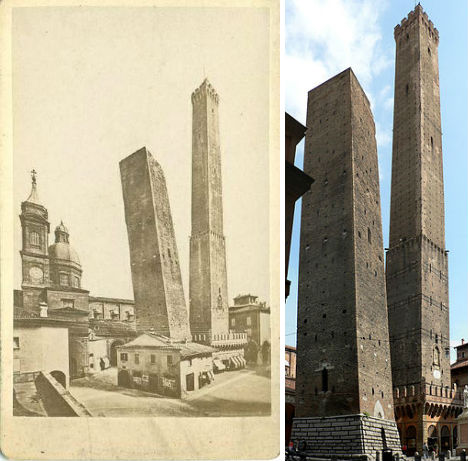Towers of Bologna
The medieval towers are a landmark of the city of Bologna. A special feature are the next to each other leaning towers Garisenda and Asinelli.
Towers
Between the 12th and the 13th century, many towers were built in the city (some sources report 180 towers ). In modern times, the city was enriched by the towers in the exhibition area ( Fiera District ), the Japanese architect Kenzo Tange has planned, and who resort to the medieval architectural tradition of the city. It is not yet clear why so many towers were built, but it is believed that the richest families used it as a means of attack and defense in the era of the Investiture Controversy.
In addition to the towers are still preserved some torresotti, small weirs on the ancient walls from the 12th century ( mura dei Torresotti o dei Mille ), which was almost completely destroyed.
During the 13th century, many towers were either razed or dismantled, others collapsed. Later she served as a variety of settings: prison, civil towers, shops, apartments. The last towers were in the 20th century as a result of an ambitious and - reduced unsustainable urban regeneration - from today's perspective. So the towers Artemisi and Riccadonnadie that lay in the district Mercato di Mezzo in addition to current leaning towers were blown up in 1917.
Of the numerous towers that adorned the city of Bologna in ancient times, have been preserved almost twenty today. Below the tower Azzoguidi called Altabella (61 meters ), the tower Prendiparte called coronata are (60 m), the towers Scappi (39 m), Uguzzoni (32 m), Guidozagni, Galluzzi and the Towers Asinelli (97 m) and Garisenda ( 48 m).
Construction techniques
Despite the commitment Erbuntertanen the construction of the towers was very expensive. The towers had a square plan with 5-10 meter deep foundations consisting of piles that were driven into the covered with gravel and limestone floor.
The cornerstone of the towers were built with huge stone blocks of selenite and the remaining structure was ie with a very thick inner wall and a thinner outer wall built with thinner and lighter walls in shell design. The inner cavity was then filled with mortar and bricks.
In general, holes were drilled to allow scaffolding or other construction work in the exterior walls.
The two leaning towers Asinelli and Garisenda
The two leaning towers, the symbol of the city, located at the intersection of the paths that lead to the five gates of the old city walls of the Torresotti. The schiefste tower Garisenda was repeatedly mentioned by Dante Alighieri in the Divine Comedy and the Rime, which testifies to the poet's stay in the city.
The names Asinelli (higher ) and Garisenda ( the smaller one ), come from families that made them build 1109-1119.
It is believed that the tower Asinelli was originally about 60 meters high and was later increased to today's 97.20 m ( with a slope of 2.20 m).
The municipality acquired the tower in the 14th century and rebuilt it into a dungeon and a castle. Around the tower, a wooden structure was built, which applied to 30 m above the ground and ( destroyed in 1398 in a major fire ) was coupled to the Garisenda by an air bridge. Severe damage suffered the tower because of the many flashes, which brought frequent fires or small disruptions. Only in 1824 a lightning protection system was installed.
The scientists Giovanni Riccioli (1640) and Giovanni Battista Guglielmini ( in the following century ) used the tower as a laboratory for research on the gravity and the Earth's rotation.
The Garisenda today has a height of 48 m and a slope of 3.20 m. After the end of construction he was about 60 meters high and was built back in the 14th century because of a soil fall, which made him dangerous angle. In the 15th century, the weavers' guild earned the tower and kept it until the end of the 19th century. Then he went into community property.
End of the 20th century, a television antenna from the Italian state broadcasting company was built on the top.
Towers and Torresotti the city walls
- Torre Accursi (so-called dell'orologio ) - Piazza Maggiore
- Torre Agresti - P.zza Galileo
- Torre Alberici - Via S. Stefano - P.zza della Mercanzia
- Torre Asinelli - P.zza Ravegnana, 82
- Torre Azzoguidi (so-called Altabella ) - Via Altabella, 7
- Torre Bertolotti - Clarissimi - Via Farini, 11
- Torre Carrari - Via Marchesana
- Torre Catalani - Vicolo Spirito Santo
- Torre Conoscenti - Via Manzoni, 6 ( on the courtyard from the Museo Civico Medioevale )
- Torre dell'Arengo - Piazza Maggiore
- Torre Galluzzi - Corte Galluzzi
- Torre Garisenda - P.zza Ravegnana
- Torre Ghisilieri - Via Nazario Sauro
- Torre Guidozagni - Via Albiroli 1-3
- Torre Lambertini - Piazza Re Enzo
- Torre Lapi - Via IV Novembre
- Torre Oseletti - Strada Maggiore, 34-36
- Torre Prendiparte (so-called coronata ) - Via S. Alò, 7
- Torre Scappi - Via Indipendenza 1
- Torre Toschi - P.zza Minghetti behind Casa Policardi
- Torre Uguzzoni - Vicolo Mandria, 1
- Torresotto di Castiglione - Via Castiglione, 47
- Torre di Porta Nuova or Otto del Pratello - via Porta Nuova, via M. Finzi
- Torre dei Otto Piella or porta Govese or del Mercato - via Piella, via Bertiera
- Torresotto di S. Vitale - Via S. Vitale, 56
The staircase inside the tower Asinelli
Torresotto of Castiglione
The Torresotto of San Vitale ( remnant " of Torresotti " from the 12th century )










